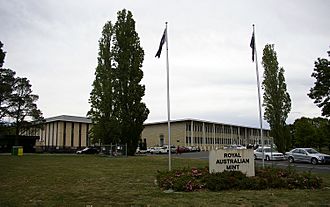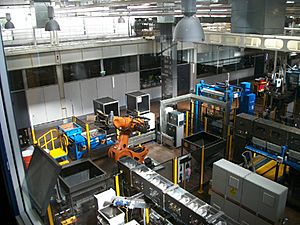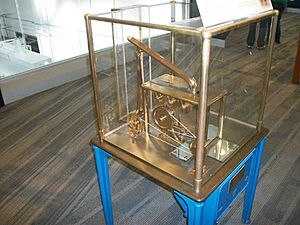Royal Australian Mint facts for kids
Quick facts for kids Royal Australian Mint |
|
|---|---|
 |
|
 |
|
| General information | |
| Location | Deakin, Australian Capital Territory |
| Opened | 22 February 1965 |
| Owner | Australian Government |
| Design and construction | |
| Architect | Richard Ure |
| Architecture firm | Department of Works |
| Main contractor | Civil and Civic E. S. Clementson Pty Ltd |
The Royal Australian Mint is where Australia's coins are made! It's the main place that produces all the coins you use every day. This special factory is located in Canberra, Australia's capital city, in a suburb called Deakin. Prince Philip, Duke of Edinburgh officially opened the Mint in 1965.
Before the Royal Australian Mint opened, Australian coins were made at other places. These included the Sydney Mint, Melbourne Mint, and Perth Mint. The Royal Australian Mint was the first one in Australia to be completely independent. It didn't rely on the British Royal Mint in the United Kingdom. Out of the older Australian mints, only the Perth Mint is still around today.
Contents
Minting Australia's Money
The Royal Australian Mint is a very important place. It makes all the legal coins for Australia. This means every coin you find in your pocket, from 5 cents to two dollars, was likely made here. The Mint also creates special medals for military and civilian awards. One of the most famous is the Order of Australia medal.
The Mint also produced medals for the 2000 Summer Olympics in Sydney. They worked with the Perth Mint on this big project. Besides coins and medals, the Royal Australian Mint makes tokens. These are used by businesses like casinos or car washes.
How the Mint Started
Planning for the Mint began in 1959. The idea was to move the coin-making from Melbourne to Canberra. A large area in the Canberra suburb of Deakin was chosen. Richard Ure, a chief architect, designed the building. He used a style called International style.
The Mint officially opened on February 22, 1965. This was just before Australia switched to decimal currency. Australia started using dollars and cents on February 14, 1966. The whole project cost about £4.5 million back then. The Prime Minister at the time, Harold Holt, said the Mint was a "gracious and dignified building." He also noted it had the best equipment and modern coin-making methods.
Growing Production
For a while, the new Mint and the Melbourne Mint both made coins. This was to make sure there were enough new coins ready. Once the Canberra Mint was running smoothly, the Melbourne Mint closed in 1967. Some staff from Melbourne moved to Canberra to work at the new Mint.
It took until the early 1980s for the Royal Australian Mint to make all of Australia's coins by itself. Before that, sometimes other mints helped out. Coins were made by the Perth Mint, the Royal Mint in London, and even the Royal Canadian Mint.
Inside the Mint Buildings
The Royal Australian Mint has two main buildings. One is for administration, and the other is for the actual coin-making process. The administration building has special areas. These include where engravers work on coin designs. There's also a laboratory and a basement. This basement is very stable, so coins can be measured precisely. This ensures they are the correct size and weight.
The Mint is part of the Australian Public Service. It works under the Department of the Treasury.
Modern Updates and Technology
Between 1984 and 1986, the Mint was updated. These changes helped them make more collector coins. They also made the visitor areas better. Today, visitors can even make their own legal coin using special presses!
More big changes happened from 2006 to 2009. The Mint was refurbished at a cost of A$41.2 million. This project brought in industrial robots to help with manufacturing. These robots make the coin-making process even more efficient. The Mint is now fully open to the public again.
Since it opened, the Mint has made over fifteen billion coins! It can produce two million coins every single day. The Mint has also made coins for many other countries. These include New Zealand, Papua New Guinea, Tonga, Fiji, Malaysia, and Israel.
Cool Coin Innovations
In November 2001, the Mint made a world-first coin. It had a double hologram to celebrate 100 years of Australian federation. The Mint also creates special coins with two different metals. They even make coins with colours printed on them!
Images for kids
-
The gold coat of arms of Australia is featured above the entrance to the Royal Australian Mint. It was produced by E. S. Clementson Pty Ltd for £500.
See also
- List of mints




